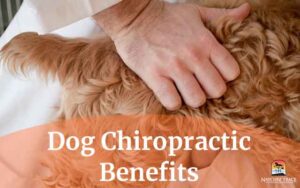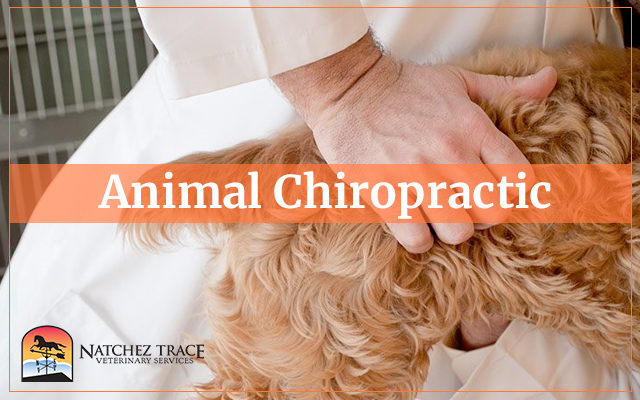What is Animal Chiropractic? Animal chiropractic is an emerging sub specialization for Doctors of Veterinary Medicine (DVMs) and Doctors of Chiropractic (DCs) to provide spinal manipulation, manual therapy, and other holistic and conservative techniques for animals.
In concert with conventional veterinary care, the complementary use of animal chiropractic is primarily used for common neuro-musculoskeletal conditions. Purported benefits of animal chiropractic include; enhanced performance and function and preservation of an acceptable quality of life.
As mentioned prior, animal chiropractic is a field of animal health care that focuses on the preservation and health of the neuro-musculoskeletal system.
Why Is the Nervous System So Important?
Because nerves control and regulate everything that happens in your pet’s body, they must function properly. Digestion, locomotion, immune system function and tissue growth and repair are all under the broad control and maintenance of the nervous system. This system must function properly in order to maintain health.
Anything adversely affecting the nervous system will have detrimental effects resonating throughout the entire body.
The command centers of the nervous system are the brain and spinal cord which are protected by the skull and bony spinal column respectively. Nerves travel from the brain down the cord and exit the cord through the bony spine or vertebra into the body.
The bony spine is a complex framework of bones (vertebra), ligaments, and muscles. If the movement and biomechanics of the bony vertebra become dysfunctional or altered, this dysfunction can interfere with the performance of the nerves that are branching off of the spinal cord and going to the muscles and organs of the entire body.
As this occurs, your pet may lose normal mobility resulting in stiffness, tension, pain, and even organ dysfunction. Additionally, when normal movement is affected and left unattended, your animal’s entire wellbeing and quality of life may deteriorate over time.
The nervous system also coordinates the body’s ability to heal and regulate itself. Trauma, overuse, or underuse, may cause the vertebra of the spine to become fixed, and the surrounding muscles and ligaments may become compromised and inflamed.
Nerves may become trapped in these damaged, fixed tissues, or in the passages they formerly used to exit the spine. As a result, nerve signals are unable to adequately reach their destinations. When these nerve signals are hindered, the end structures change and lose their intrinsic ability to heal. This can directly and dramatically impact your animal’s health.
Symptoms of Spinal Fixation
Symptoms of spinal fixation are vast and may include the following:
- Pain,
- Spasm,
- Sensitivity to touch,
- Lameness,
- Gait abnormalities, and
- Postural compromise
These symptoms are the easiest to detect. It may take a trained doctor to distinguish some of the more subtle changes that occur when organs begin to malfunction.
The Goal of Animal Chiropractic
The goal of an animal chiropractor is to restore function and mobility to the fixed vertebra in an effort to re-establish neurologic transmissions.
This allows the body to perform at its optimum potential. Chiropractic doctors use their hands to identify areas of restriction. Once fixed areas are identified, the animal chiropractor applies a precise thrust on the immobile anatomical structures.
This treatment restores the normal motion of the vertebra thus removing neurological interference. When the nerves can efficiently communicate with all the structures in your pet’s body, your pet will begin to heal.
Incorporating Animal Chiropractic at NTVS?
Animal Chiropractic is not meant to replace traditional veterinary care. It is not a stand-alone, alternative treatment, but rather an integrative method that when used in conjunction with good traditional veterinary care, will provide years of happy and healthy living.
Now is the beginning of a more modern, comprehensive approach to your animal’s healthcare. It is an effective and valuable means of restoring and maintaining your pet’s strength, vigor, and well-being.
By exploring and treating the root causes of your animal’s aches, pains, and illnesses, we will ensure maximum improvement, top performance, and an exceptional quality of life for the animal companions you love.
Scope of Practice
Traditionally, all animal care fell under the exclusive jurisdiction of veterinarians.
With the emergence of veterinary chiropractic, both doctors of chiropractic (DCs) and veterinary medicine (DVMs) can take additional training to become certified in veterinary chiropractic.
The minimum standard for practice appears to be a minimum of 210 hours of continuing education. In some locations, a veterinarian must supervise the treatment provided by the veterinary chiropractor.
Veterinary chiropractors typically treat working horses, racing greyhounds, and pets; and recently have been used more extensively to treat ongoing, chronic pain caused by conditions of the neck and back.
Those that specialize in horses are referred to as “Equine Chiropractors.” There is and has been discussion over who should perform animal chiropractic; veterinarians, chiropractors, or both?
It is our belief that veterinarians and chiropractors who have completed the necessary 210 hours of certified continuing education are the only individuals qualified to perform chiropractic techniques on animals.
Clinical Practice
Before working on an animal, a veterinary chiropractor procures a detailed case history of the animal including prior diagnoses, therapies, and X-ray or laboratory analyses.
The American Veterinary Medical Association guidelines recommend that a veterinarian should examine an animal and establish a preliminary diagnosis before any alternative treatment, like chiropractic, is initiated.
Before performing a chiropractic adjustment, the doctor examines the animal’s gait, posture, and vertebrae, and extremities. In addition to spinal manipulation, other adjustive procedures can be performed to the extremity joints and cranial sutures.
Education
Most veterinary chiropractic programs are a minimum of 210 hours of additional training following the completion of veterinary or chiropractic school and subsequent licensure.
Practitioners will be able to complete an appropriate history, physical examination, communicate a diagnosis and plan of management, and provide care when indicated within their respective scopes of practice.
Though there is variation, common topics covered in veterinary chiropractic programs can include:
- Anatomy
- Basic and advanced Neurology
- Rehabilitation Therapy
- Complementary and alternative medicine modalities
- Philosophy
- Basic and advanced chiropractic manipulative techniques

Dog Chiropractic and Its 7 Wonderful Benefits
In the ever-evolving landscape of veterinary care, a holistic approach to nurturing your furry companions’ health takes center stage. Enter dog chiropractic care—a specialized discipline

The Top 5 Benefits of Chiropractic for Pets
Why choose chiropractic for pets? As a devoted pet owner, your furry friend’s health and happiness are undoubtedly your top priorities. Of course, traditional veterinary





